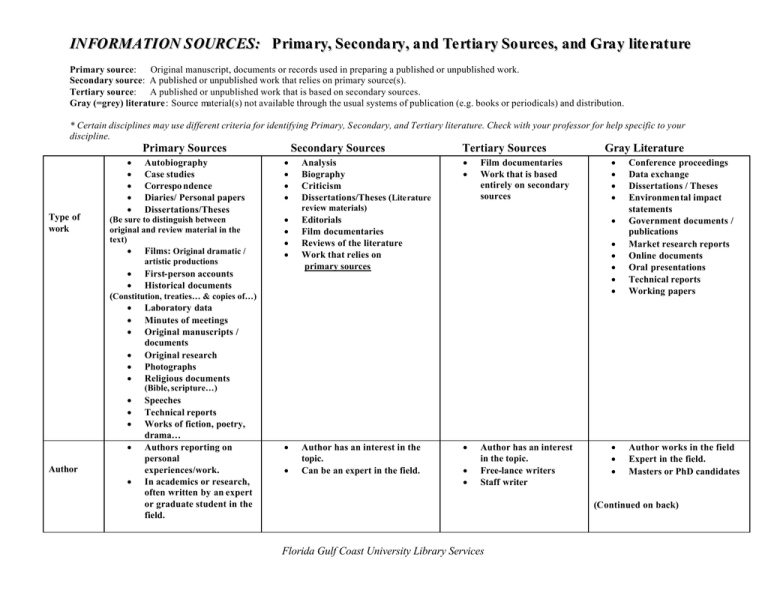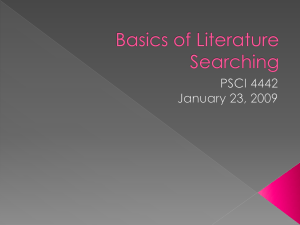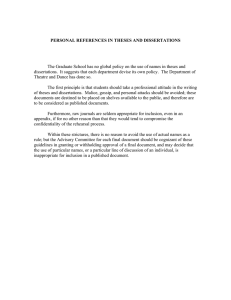INFORMATION SOURCES: Primary, Secondary, and Tertiary
advertisement

IN FO RMATI ON S OURC ES: P rima ry, Se c onda ry, a nd Te rt ia ry So urc e s, and G ra y lite rat ure Primary source: Original manuscript, documents or records used in preparing a published or unpublished work. Secondary source: A published or unpublished work that relies on primary source(s). Tertiary source: A published or unpublished work that is based on secondary sources. Gray (=grey) literature: Source material(s) not available through the usual systems of publication (e.g. books or periodicals) and distribution. * Certain disciplines may use different criteria for identifying Primary, Secondary, and Tertiary literature. Check with your professor for help specific to your discipline. Primary Sources Type of work • • • • • Autobiography Case studies Correspo ndence Diaries/ Personal papers Dissertations/Theses (Be sure to distinguish between original and review material in the text) • Films: Original dramatic / artistic productions • • Secondary Sources • • • • Analysis Biography Criticism Dissertations/Theses (Literature Tertiary Sources • • Film documentaries Work that is based entirely on secondary sources Gray Literature • • • • • • • • • Conference proceedings Data exchange Dissertations / Theses Environmental impact statements Government documents / publications Market research reports Online documents Oral presentations Technical reports Working papers • • • Author works in the field Expert in the field. Masters or PhD candidates review materials) • • • • Editorials Film documentaries Reviews of the literature Work that relies on primary sources • Author has an interest in the topic. Can be an expert in the field. First-person accounts Historical documents • (Constitution, treaties… & copies of…) • Laboratory data • Minutes of meetings • Original manuscripts / documents • Original research • Photographs • Religious documents (Bible, scripture…) • • • • Author • Speeches Technical reports Works of fiction, poetry, drama… Authors reporting on personal experiences/work. In academics or research, often written by an expert or graduate student in the field. • • • • Author has an interest in the topic. Free-lance writers Staff writer (Continued on back) Florida Gulf Coast University Library Services IN FO RMATI ON S OURC ES: P rima ry, Se c onda ry, a nd Te rt ia ry So urc e s, and G ra y lite rat ure Primary Sources Where published • • • • • Books Gray literature Monograph Scholarly journal Refereed/peer reviewed journal Secondary Sources • • • • • • • Books Encyclopedias Gray literature Newspapers Pamphlets Scholarly journal Refereed/peer reviewed journal Tertiary Sources • • • • • Books / textbooks Gray literature Magazines Newspapers Trade journals Primary, Secondary and Tertiary Literature can be found in a variety print sources and electronic databases. Gray Literature • • • Business / Industry publications Government publications (Federal, state & local) Unpublished dissertation / Theses Gray literature is also found in a variety of print sources and electronic databases, though sometimes can be harder to locate. Some examples are: • Caloosahatchee Documents • Charlotte Harbor Info. • Dissertation Abstracts • GrayLIT Network Where Found • • http://www.osti.gov/graylit/ Library of Congress loc.gov • • • • • • National Sea Grant Lib http://nsgd.gso.uri.edu/ NCJRS ncjrs.org/ NOAA noaa.gov NTIS ntis.gov PapersFirst database Proceedings Scientific & Technical Information Network • US Census Bureau http://stinet.dtic.mil/ census.gov • • USDA USGS usda.gov usgs.gov Revised 08/2005 Florida Gulf Coast University Library Services




